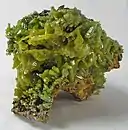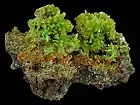Pyromorphite
Pyromorphite is a mineral species composed of lead chlorophosphate: Pb5(PO4)3Cl, sometimes occurring in sufficient abundance to be mined as an ore of lead. Crystals are common, and have the form of a hexagonal prism terminated by the basal planes, sometimes combined with narrow faces of a hexagonal pyramid. Crystals with a barrel-like curvature are not uncommon. Globular and reniform masses are also found. It is part of a series with two other minerals: mimetite (Pb5(AsO4)3Cl) and vanadinite (Pb5(VO4)3Cl), the resemblance in external characters is so close that, as a rule, it is only possible to distinguish between them by chemical tests. They were formerly confused under the names green lead ore and brown lead ore (German: Grünbleierz and Braunbleierz).
| Pyromorphite | |
|---|---|
 | |
| General | |
| Category | Phosphate mineral Apatite group |
| Formula (repeating unit) | Pb5(PO4)3Cl |
| Strunz classification | 8.BN.05 |
| Crystal system | Hexagonal |
| Crystal class | Dipyramidal (6/m) (same H-M symbol) |
| Space group | P63/m |
| Identification | |
| Color | Dark green to grass-green or green, yellow, yellow-orange, reddish orange, yellow-brown, greenish-yellow or yellowish-green, shades of brown, tan, grayish, white and may be colorless; colourless or faintly tinted in transmitted light. |
| Crystal habit | Prismatic to acicular crystals, globular to reniform |
| Twinning | Rarely on {1122} |
| Cleavage | Imperfect- [1011] |
| Fracture | Uneven to sub-conchoidal |
| Tenacity | Brittle |
| Mohs scale hardness | 3.5-4 |
| Luster | Resinous to subadamantine |
| Streak | White |
| Diaphaneity | Transparent to translucent |
| Specific gravity | 7.04 measured, 7.14 calculated |
| Optical properties | Uniaxial (-) May be anomalously biaxial - |
| Refractive index | nω = 2.058 nε = 2.048 |
| Birefringence | δ = 0.010 |
| Pleochroism | Weak |
| Ultraviolet fluorescence | May fluoresce yellow to orange under LW and SW UV |
| Other characteristics | Piezoelectric if biaxial |
| References | [1][2][3] |
The phosphate was first distinguished chemically by M. H. Klaproth in 1784,[4][5] and it was named pyromorphite by J. F. L. Hausmann in 1813.[6][7] The name is derived from the Greek for pyr (fire) and morfe (form) due to its crystallization behavior after being melted.[2]
Paecilomyces javanicus is a mold collected from a lead-polluted soil that is able to form biominerals of pyromorphite.[8]
Properties and isomorphism
The color of the mineral is usually some bright shade of green, yellow or brown, and the luster is resinous. The hardness is 3.5 to 4, and the specific gravity 6.5 - 7.1. Owing to isomorphous replacement of the phosphorus by arsenic there may be a gradual passage from pyromorphite to mimetite. Varieties containing calcium isomorphously replacing lead are lower in density (specific gravity 5.9 - 6.5) and usually lighter in color; they bear the names polysphaerite (because of the globular form), miesite from Mies in Bohemia, nussierite from Nuizière, Chénelette, near Beaujeu, Rhône, France, and cherokine from Cherokee County in Georgia.
Image gallery
 A pocket of crystals of pyromorphite from China
A pocket of crystals of pyromorphite from China Miniature of sharp, lustrous, apple green color crystal "sprays" on matrix
Miniature of sharp, lustrous, apple green color crystal "sprays" on matrix Fine crystals of pyromorphite from Daoping Mine, Guangxi Zhuang Autonomous Region, China
Fine crystals of pyromorphite from Daoping Mine, Guangxi Zhuang Autonomous Region, China Green pyromorphite crystals densely carpet the display side of the large matrix
Green pyromorphite crystals densely carpet the display side of the large matrix
See also
References
- http://rruff.geo.arizona.edu/doclib/hom/pyromorphite.pdf Handbook of Mineralogy
- http://webmineral.com/data/Pyromorphite.shtml Webmineral data
- http://www.mindat.org/min-3320.html Mindat.org
- See:
- Klaproth (1784) "Von dem Wassereisen, als einem mit Phosphorsäure verbundenen Eisenkalke" (On hydrosiderum [i.e., iron phosphide, Fe2P] as a calcined [i,e, roasted] iron [that is] bonded with phosphoric acid), Chemische Annalen für die Freunde der Naturlehre … , 1 (5) : 390–399. From p. 394: After remarking that lead ores that contain phosphorus can be treated with strong acids to produce phosphoric acid, Klaproth notes that: " … wie solches zuerst Hr. Gahn in Schweden entdeckt, ich selbst aber bey Unersuchung des krystallisirten grünen Bleyerzes von der heil. Dreyfaltigkeit zu Zschopau bestätigt gefunden habe." ( … as such Mr. Gahn in Sweden first discovered, I myself, however, have found [to be] confirmed by investigation of the crystallized green lead ore [i.e., pyromorphite] from the Holy Trinity at Zschopau [in Germany].)
- Klaproth (1785) "Ueber die Phosphorsäure im Zschopauer grünen Bleyspathe" (On phosphoric acid in green lead spar from Zschopau), Beyträge zu den chemischen Annalen, 1 (1) : 13–21.
- "LXXXVII. Chemische Untersuchung der phosphorsauren Bleierze: I. Zeisiggrünes Bleierz von Zschopau." (87. Chemical investigation of the lead ores [containing] phosphoric acid: I. Siskin-green lead ore from Zschopau) in: Klaproth, Martin Heinrich, Beiträge zur chemischen Kenntnis der Mineralkörper [Contributions to our chemical knowledge of minerals] (Posen, (Germany): Decker und Co. ; Berlin, (Germany): Heinrich August Rottmann, 1802), vol. 3, pp. 146–153.
- Entdeckung von Pyromorphit (Discovery of pyromorphite) by Dr. Thomas Witzke (in German)
- Hausmann, Johann Friedrich Ludwig, Handbuch der Mineralogie (Göttingen, (Germany): Vandenhoeck und Ruprecht, 1813), pp. 1090–1093.
- Chester, Albert Huntington, A Dictionary of the Names of Minerals Including Their History and Etymology (New York, New York: John Wiley & Sons, 1896), p. 224.
- Fungal transformation of metallic lead to pyromorphite in liquid medium. Young Joon Rheea, Stephen Hillierc, d, Helen Pendlowskic, Geoffrey Michael Gadd. Chemosphere. Volume 113, October 2014, Pages 17–21
 This article incorporates text from a publication now in the public domain: Chisholm, Hugh, ed. (1911). "Pyromorphite". Encyclopædia Britannica. 22 (11th ed.). Cambridge University Press. pp. 693–694.
This article incorporates text from a publication now in the public domain: Chisholm, Hugh, ed. (1911). "Pyromorphite". Encyclopædia Britannica. 22 (11th ed.). Cambridge University Press. pp. 693–694.
External links
| Wikimedia Commons has media related to Pyromorphite. |